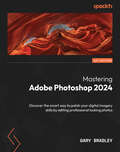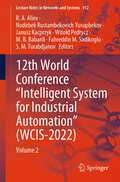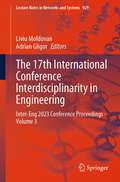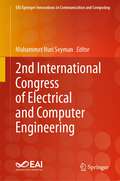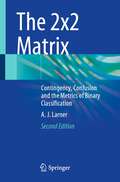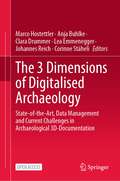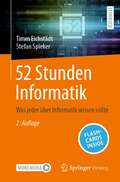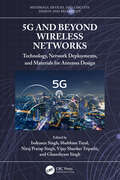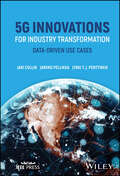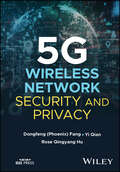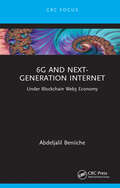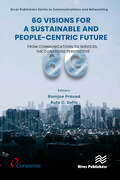- Table View
- List View
Mastering Julia: Enhance your analytical and programming skills for data modeling and processing with Julia
by Malcolm SherringtonA hands-on, code-based guide to leveraging Julia in a variety of scientific and data-driven scenariosKey FeaturesAugment your basic computing skills with an in-depth introduction to JuliaFocus on topic-based approaches to scientific problems and visualisationBuild on prior knowledge of programming languages such as Python, R, or C/C++Purchase of the print or Kindle book includes a free PDF eBookBook DescriptionJulia is a well-constructed programming language which was designed for fast execution speed by using just-in-time LLVM compilation techniques, thus eliminating the classic problem of performing analysis in one language and translating it for performance in a second. This book is a primer on Julia’s approach to a wide variety of topics such as scientific computing, statistics, machine learning, simulation, graphics, and distributed computing. Starting off with a refresher on installing and running Julia on different platforms, you’ll quickly get to grips with the core concepts and delve into a discussion on how to use Julia with various code editors and interactive development environments (IDEs). As you progress, you’ll see how data works through simple statistics and analytics and discover Julia's speed, its real strength, which makes it particularly useful in highly intensive computing tasks. You’ll also and observe how Julia can cooperate with external processes to enhance graphics and data visualization. Finally, you will explore metaprogramming and learn how it adds great power to the language and establish networking and distributed computing with Julia. By the end of this book, you’ll be confident in using Julia as part of your existing skill set.What you will learnDevelop simple scripts in Julia using the REPL, code editors, and web-based IDEsGet to grips Julia’s type system, multiple dispatch, metaprogramming, and macro developmentInteract with data files, tables, data frames, SQL, and NoSQL databasesDelve into statistical analytics, linear programming, and optimization problemsCreate graphics and visualizations to enhance modeling and simulation in JuliaUnderstand Julia's main approaches to machine learning, Bayesian analysis, and AIWho this book is forThis book is not an introduction to computer programming, but a practical guide for developers who want to enhance their basic knowledge of Julia, or those wishing to augment their skill set by adding Julia to their existing roster of programming languages. Familiarity with a scripting language such as Python or R, or a compiled language such as C/C++, C# or Java, is a prerequisite.
Microsoft Intune Cookbook: Over 75 recipes for configuring, managing, and automating your identities, apps, and endpoint devices
by Andrew TaylorGet started with Microsoft Intune and explore its many facets, including task automation with Microsoft GraphKey FeaturesCreate and configure your new mobile device management (MDM) environmentBecome an Intune pro by mastering compliance policies, monitoring techniques, reporting practices, and application deployment proceduresLearn how to manage Windows, Android, iOS, and macOS devices using IntunePurchase of the print or Kindle book includes a free PDF eBookBook DescriptionMicrosoft Intune is a cloud-managed mobile device management (MDM) tool that empowers you to manage your end-user device estate across various platforms. While it is an excellent platform, the initial setup and configuration can be a daunting process, and mistakes made early on can be more challenging to resolve later. This book addresses these issues by guiding you through the end-to-end configuration of an Intune environment, incorporating best practices and utilizing the latest functionalities. In addition to setting up your environment, you’ll delve into the Microsoft Graph platform to understand the underlying mechanisms behind the web GUI. This knowledge will enable you to automate a significant portion of your daily tasks using PowerShell. By the end of this book, you’ll have established an Intune environment that supports Windows, Apple iOS, Apple macOS, and Android devices. You’ll possess the expertise to add new configurations, policies, and applications, tailoring an environment to your specific requirements. Additionally, you’ll have the ability to troubleshoot any issues that may arise and package and deploy your company applications. Overall, this book is an excellent resource for anyone who wants to learn how to use Microsoft Intune to manage their organization's end-user devices.What you will learnSet up your Intune tenant and associated platform connectionsCreate and deploy device policies to your organization's devicesFind out how to package and deploy your applicationsExplore different ways to monitor and report on your environmentLeverage PowerShell to automate your daily tasksUnderstand the underlying workings of the Microsoft Graph platform and how it interacts with IntuneWho this book is forThis book is for IT professionals, end-user device administrators, and system administrators looking to transition to cloud-managed devices or enhance their current environment.
Oracle Linux Cookbook: Embrace Oracle Linux and master Linux Server Management
by Erik Benner Erik B. Thomsen Jonathan SpindelGet to grips with cloud security fundamentals, uncover cloud exploits, and safeguard your organization's network through effective pentesting of AWS, Azure, and GCPKey FeaturesEffortlessly upgrade from Oracle Linux 7 or migrate from CentOSBecome a pro sysadmin by learning new tricks to manage your Oracle Linux serversLearn how to install, configure, administer, and maintain Oracle Linux serversPurchase of the print or Kindle book includes a free PDF eBookBook DescriptionDiscover the power of Oracle Linux 8, the free and enterprise-grade Linux distribution designed for use in any environment, with this recipe-style book. Starting with instructions on how to obtain Oracle Linux for both X86 and ARM-based platforms, this book walks you through various installation methods, from running it as a Windows service to installing it on a Raspberry Pi. It unravels advanced topics such as system upgrades using Leapp for major version transitions and using a PXE server and kickstart files for more advanced installations. The book then delves into swapping kernels to take advantage of Oracle’s UEK, exploring boot options, managing software with DNF, and achieving high availability. Detailed recipes involving security topics will assist with tasks such as data encryption, both at rest and in motion. For developers, it offers guidance on building RPM files, using Docker and Podman in a containerized environment, working with AppStreams, and more. For large-scale deployments, the book introduces Oracle Linux Automation Manager for enterprise-level Ansible utilization, from setting up the Ansible server to basic playbook writing. Finally, you’ll discover strategies for cloud migration. By the end of this book, you’ll possess a comprehensive toolkit that will elevate your skills as a Linux administrator.What you will learnMaster the use of DNF for package management and stream-specific installationsImplement high availability services through Podman and Oracle Linux Automation ManagerSecure your system with Secure Boot and at-rest disk encryption techniquesAchieve rebootless system updates using the Ksplice technologyOptimize large-scale deployments with Oracle Linux Automation Manager and AnsibleGain practical insights into storage management using Btrfs and LVMWho this book is forThis book is for existing Oracle Linux system administrators and CentOS or RHEL admins contemplating a migration to Oracle Linux 8. A foundation of basic sysadmin skills is assumed as this is not an entry-level book; it's a cookbook focused on complex and lesser-known configurations specifically for Oracle Linux 8.
Building Real-World Web Applications with Vue.js 3: Build a portfolio of Vue.js and TypeScript web applications to advance your career in web development
by Joran QuintenBecome a VueJS professional through practical projects like building a to-do list, weather app, recipe app, fitness tracker, quiz app, and moreKey FeaturesIncrease your prospects of securing employment as a web developerFamiliarize yourself with the Vue ecosystem and build more advanced applications by leveraging the fundamentalsProgress at your own pace and build a personal project using a modern tech stackPurchase of the print or Kindle book includes a free PDF eBookBook DescriptionIn the ever-evolving web development landscape, Vue.js stands out with its intuitive design and progressive framework, empowering developers to create interactive and dynamic web applications. This book will help you stay in the forefront of modern web technologies by mastering Vue.js through hands-on projects and practical applications. Building Real-World Web Applications with Vue.js 3 is your guide to exploring the core concepts of Vue.js, setting up your development environment, and creating your first Vue.js application. You’ll progress by building a recipe app using Vuetify, followed by leveraging data visualization to create a fitness tracker featuring dynamic dashboards using external databases and Vue-ChartJS. You'll then get to grips with multiplatform development with Quasar to deploy your app. As you develop an interactive quiz app, you’ll be introduced to server-side logic with Nuxt.js, WebSockets for real-time communication, and client-server differentiation. Additionally, you’ll study experimental object recognition using TensorFlow, leveraging machine learning and camera input, and conclude by creating a portfolio website with Nuxt and Storyblok. By the end of this book, you'll have the knowledge and confidence to create your own Vue.js applications and build a portfolio to showcase your Vue.js skills to potential employers.What you will learnMaster VueJS fundamentals and best practicesBuild real-world applications and create a portfolioUse VueRouter and manage state with PiniaImplement Vuetify for rapid UI developmentDevelop multiplatform apps with Quasar FrameworkCreate interactive quizzes using WebSocket connectionsApply TensorFlow for object recognitionBuild a portfolio website with Nuxt and Storyblok CMSWho this book is forThis book is for aspiring Vue.js developers eager to dive into practical projects. Whether you're just starting your Vue.js journey or have basic knowledge of JavaScript and web technologies, this book is a valuable resource, taking a hands-on approach to establishing a solid foundation in Vue.js while working on a variety of real-world projects.
Learn LLVM 17: A beginner's guide to learning LLVM compiler tools and core libraries with C++
by Kai Nacke Amy KwanLearn how to build and use the complete spectrum of real-world compilers, including the frontend, optimization pipeline, and a new backend by leveraging the power of LLVM core librariesKey FeaturesGet to grips with using LLVM libraries step by stepUnderstand the high-level design of LLVM compilers and apply these principles to your own compilerAdd a new backend to target an unsupported CPU architecturePurchase of the print or Kindle book includes a free PDF eBookBook DescriptionLLVM was built to bridge the gap between the theoretical knowledge found in compiler textbooks and the practical demands of compiler development. With a modular codebase and advanced tools, LLVM empowers developers to build compilers with ease. This book serves as a practical introduction to LLVM, guiding you progressively through complex scenarios and ensuring that you navigate the challenges of building and working with compilers like a pro. The book starts by showing you how to configure, build, and install LLVM libraries, tools, and external projects. You’ll then be introduced to LLVM's design, unraveling its applications in each compiler stage: frontend, optimizer, and backend. Using a real programming language subset, you'll build a frontend, generate LLVM IR, optimize it through the pipeline, and generate machine code. Advanced chapters extend your expertise, covering topics such as extending LLVM with a new pass, using LLVM tools for debugging, and enhancing the quality of your code. You'll also focus on just-in-time compilation issues and the current state of JIT-compilation support with LLVM. Finally, you’ll develop a new backend for LLVM, gaining insights into target description and how instruction selection works. By the end of this book, you'll have hands-on experience with the LLVM compiler development framework through real-world examples and source code snippets.What you will learnConfigure, compile, and install the LLVM frameworkUnderstand how the LLVM source is organizedDiscover what you need to do to use LLVM in your own projectsExplore how a compiler is structured, and implement a tiny compilerGenerate LLVM IR for common source language constructsSet up an optimization pipeline and tailor it for your own needsExtend LLVM with transformation passes and clang toolingAdd new machine instructions and a complete backendWho this book is forThis book is for compiler developers, enthusiasts, and engineers new to LLVM. C++ software engineers looking to use compiler-based tools for code analysis and improvement, as well as casual users of LLVM libraries who want to gain more knowledge of LLVM essentials will also find this book useful. Intermediate-level experience with C++ programming is necessary to understand the concepts covered in this book.
Mastering Adobe Photoshop 2024: Discover the smart way to polish your digital imagery skills by editing professional looking photos
by Gary BradleyUnleash your digital creativity by mastering complex editing tools and features to work smarter and faster for high-end resultsKey FeaturesCreate, manage, and deliver captivating visuals for print, screen, and the web using proven industry techniquesManage your digital projects with granular control and confidenceBecome an expert and eliminate last-minute Google searches to overcome challengesPurchase of the print or Kindle book includes a free PDF eBookBook DescriptionUnlock the full potential of Photoshop, the go-to app for content creators by mastering its complex tools and features. This book quickly builds on your existing Photoshop knowledge with proven industry techniques, serving as a launchpad to develop professional skills and transformative personal growth. You’ll start by fine-tuning color and tone in your images with non-destructive adjustment layers and conceal content like backdrops with precise masking techniques for fine details like hair. Working through a series of real-world editing projects, crafting realistic brand mockups and traditional marketing collateral, you’ll learn robust methods for building social media assets in Photoshop, from images to animated GIFs and videos. You’ll also be able to bring your typography to life with styles and effects that are simple to edit and store as preset effects. The final section of the book encapsulates all of your learning to create complex montages using advanced masking and compositing techniques. You’ll have fun elevating your designs with surreal art styles and conceptual imagery using retouching, blending, and liquify filters. By the end of this Adobe Photoshop book, you’ll soar to new heights with your designs, creating captivating visuals that leave a lasting impression on your audience.What you will learnDiscover new ways of working with familiar tools, enhancing your existing knowledge of PhotoshopMaster time-saving retouching techniques, ensuring flexibility for repeated edits without compromising on qualityCreate precise image cut-outs and seamless montages with advanced masking toolsMake Photoshop your go-to application for social media contentAutomate repetitive tasks with actions and scripts that batch-process hundreds of images in secondsIntegrate vector assets, type styles, and brand colors from other CC applicationsWho this book is forThis book is for designers, marketers, and online content creators who work with digital imagery regularly. If you use Photoshop to create projects for print, screen, or social, this book will help you take your skills to the next level.
Modern DevOps Practices: Implement, secure, and manage applications on the public cloud by leveraging cutting-edge tools
by Gaurav AgarwalEnhance DevOps workflows by integrating the functionalities of Git, Docker, Kubernetes, Argo CD, Ansible, Terraform, Istio, and more with the help of practical examples and expert tipsKey FeaturesExplore containers as a service (CaaS) and infrastructure automation in the public cloudSecure and ship software continuously to production with DevOps, GitOps, SecOps, and automationOperate distributed and scalable microservices apps in the cloud with a modern service meshPurchase of the print or Kindle book includes a free PDF eBookBook DescriptionDevOps and the cloud have changed how we look at software development and operations like never before, leading to the rapid growth of various DevOps tools, techniques, and practices. This updated edition helps you pick up the right tools by providing you with everything you need to get started with your DevOps journey. The book begins by introducing you to modern cloud-native architecture, and then teaches you about the architectural concepts needed to implement the modern way of application development. The next set of chapters helps you get familiarized with Git, Docker, Kubernetes, Ansible, Terraform, Packer, and other similar tools to enable you to build a base. As you advance, you’ll explore the core elements of cloud integration—AWS ECS, GKE, and other CaaS services. The chapters also discuss GitOps, continuous integration, and continuous delivery—GitHub actions, Jenkins, and Argo CD—to help you understand the essence of modern app delivery. Later, you’ll operate your container app in production using a service mesh and apply AI in DevOps. Throughout the book, you’ll discover best practices for automating and managing your development lifecycle, infrastructure, containers, and more. By the end of this DevOps book, you'll be well-equipped to develop and operate applications using modern tools and techniques.What you will learnExplore modern DevOps practices with Git and GitOpsMaster container fundamentals with Docker and KubernetesBecome well versed in AWS ECS, Google Cloud Run, and KnativeDiscover how to efficiently build and manage secure Docker imagesUnderstand continuous integration with Jenkins on Kubernetes and GitHub ActionsGet to grips with using Argo CD for continuous deployment and deliveryManage immutable infrastructure on the cloud with Packer, Terraform, and AnsibleOperate container applications in production using Istio and learn about AI in DevOpsWho this book is forIf you are a software engineer, system administrator, or operations engineer looking to step into the world of DevOps within public cloud platforms, this book is for you. Existing DevOps engineers will also find this book helpful as it covers best practices, tips, and tricks for implementing DevOps with a cloud-native mindset. Although no containerization experience is necessary, a basic understanding of the software development life cycle and delivery will help you get the most out of this book.
Observability with Grafana: Monitor, control, and visualize your Kubernetes and cloud platforms using the LGTM stack
by Rob Chapman Peter HolmesImplement the LGTM stack for cost-effective, faster, and secure delivery and management of applications to provide effective infrastructure solutionsKey FeaturesUse personas to better understand the needs and challenges of observability tools usersGet hands-on practice with Grafana and the LGTM stack through real-world examplesImplement and integrate LGTM with AWS, Azure, GCP, Kubernetes and tools such as OpenTelemetry, Ansible, Terraform, and HelmPurchase of the print or Kindle book includes a free PDF eBookBook DescriptionTo overcome application monitoring and observability challenges, Grafana Labs offers a modern, highly scalable, cost-effective Loki, Grafana, Tempo, and Mimir (LGTM) stack along with Prometheus for the collection, visualization, and storage of telemetry data. Beginning with an overview of observability concepts, this book teaches you how to instrument code and monitor systems in practice using standard protocols and Grafana libraries. As you progress, you’ll create a free Grafana cloud instance and deploy a demo application to a Kubernetes cluster to delve into the implementation of the LGTM stack. You’ll learn how to connect Grafana Cloud to AWS, GCP, and Azure to collect infrastructure data, build interactive dashboards, make use of service level indicators and objectives to produce great alerts, and leverage the AI & ML capabilities to keep your systems healthy. You’ll also explore real user monitoring with Faro and performance monitoring with Pyroscope and k6. Advanced concepts like architecting a Grafana installation, using automation and infrastructure as code tools for DevOps processes, troubleshooting strategies, and best practices to avoid common pitfalls will also be covered. After reading this book, you’ll be able to use the Grafana stack to deliver amazing operational results for the systems your organization uses.What you will learnUnderstand fundamentals of observability, logs, metrics, and distributed tracesFind out how to instrument an application using Grafana and OpenTelemetryCollect data and monitor cloud, Linux, and Kubernetes platformsBuild queries and visualizations using LogQL, PromQL, and TraceQLManage incidents and alerts using AI-powered incident managementDeploy and monitor CI/CD pipelines to automatically validate the desired resultsTake control of observability costs with powerful in-built featuresArchitect and manage an observability platform using GrafanaWho this book is forIf you’re an application developer, a DevOps engineer, a SRE, platform engineer, or a cloud engineer concerned with Day 2+ systems operations, then this book is for you. Product owners and technical leaders wanting to gain visibility of their products in a standardized, easy to implement way will also benefit from this book. A basic understanding of computer systems, cloud computing, cloud platforms, DevOps processes, Docker or Podman, Kubernetes, cloud native, and similar concepts will be useful.
Unlocking the Secrets of Prompt Engineering: Master the art of creative language generation to accelerate your journey from novice to pro
by Gilbert MizrahiEnhance your writing with AI by mastering prompt engineering techniques and become an expert in developing and utilizing LLM prompts across applicationsKey FeaturesMaster prompt engineering techniques to harness AI's writing potentialDiscover diverse LLM applications for content creation and beyondLearn through practical examples, use cases, and hands-on guidancePurchase of the print or Kindle book includes a free PDF eBookBook DescriptionUnlocking the Secrets of Prompt Engineering is your key to mastering the art of AI-driven writing. This book propels you into the world of large language models (LLMs), empowering you to create and apply prompts effectively for diverse applications, from revolutionizing content creation and chatbots to coding assistance. Starting with the fundamentals of prompt engineering, this guide provides a solid foundation in LLM prompts, their components, and applications. Through practical examples and use cases, you'll discover how LLMs can be used for generating product descriptions, personalized emails, social media posts, and even creative writing projects like fiction and poetry. The book covers advanced use cases such as creating and promoting podcasts, integrating LLMs with other tools, and using AI for chatbot development. But that’s not all. You'll also delve into the ethical considerations, best practices, and limitations of using LLM prompts as you experiment and optimize your approach for best results. By the end of this book, you'll have unlocked the full potential of AI in writing and content creation to generate ideas, overcome writer's block, boost productivity, and improve communication skills.What you will learnExplore the different types of prompts, their strengths, and weaknessesUnderstand the AI agent's knowledge and mental modelEnhance your creative writing with AI insights for fiction and poetryDevelop advanced skills in AI chatbot creation and deploymentDiscover how AI will transform industries such as education, legal, and othersIntegrate LLMs with various tools to boost productivityUnderstand AI ethics and best practices, and navigate limitations effectivelyExperiment and optimize AI techniques for best resultsWho this book is forThis book is for a wide audience, including writers, marketing and business professionals, researchers, students, tech enthusiasts, and creative individuals. Anyone looking for strategies and examples for using AI co-writing tools like ChatGPT effectively in domains such as content creation, drafting emails, and inspiring artistic works, will find this book especially useful. If you are interested in AI, NLP, and innovative software for personal or professional use, this is the book for you.
Mastering MongoDB 7.0: Achieve data excellence by unlocking the full potential of MongoDB
by Marko Aleksendrić Arek Borucki Leandro Domingues Malak Abu Hammad Elie Hannouch Rajesh Nair Rachelle PalmerGain MongoDB expertise and discover advanced queries and Atlas insights with this ultimate guide to version 7.0Key FeaturesEnhance your proficiency in advanced queries, aggregation, and optimized indexing to achieve peak MongoDB performanceMonitor, back up, and integrate applications effortlessly with MongoDB AtlasImplement security thorough RBAC, auditing, and encryption to ensure comprehensive data protection and privacyPurchase of the print or Kindle book includes a free PDF eBookBook DescriptionMastering MongoDB 7.0 explores the latest version of MongoDB, an exceptional NoSQL database solution that aligns with the needs of modern web applications. This book starts with an informative overview of MongoDB’s architecture and developer tools, guiding you through the process of connecting to databases seamlessly. This MongoDB book explores advanced queries in detail, including aggregation pipelines and multi-document ACID transactions. It delves into the capabilities of the MongoDB Atlas developer data platform and the latest features, such as Atlas Vector Search, and their role in AI applications, enabling developers to build applications with the scalability and performance that today’s organizations need. It also covers the creation of resilient search functionality using MongoDB Atlas Search. Mastering MongoDB 7.0’s deep coverage of advanced techniques encompasses everything from role-based access control (RBAC) to user management, auditing practices, and encryption across data, network, and storage layers. By the end of this book, you’ll have developed the skills necessary to create efficient, secure, and high-performing applications using MongoDB. You’ll have the confidence to undertake complex queries, integrate robust applications, and ensure data security to overcome modern data challenges.What you will learnExecute advanced MongoDB queries for intricate data insightsHarness the power of aggregation pipelines to transform dataEnsure data integrity with multi-document ACID transactionsOptimize query performance using strategic indexing techniquesNavigate MongoDB Atlas seamlessly for monitoring and backupsEnable robust search functionality with Atlas SearchMaster RBAC, user management, and data encryption for securityImplement auditing practices for transparency and accountabilityWho this book is forThis book is for developers with an intermediate skill level who aim to become MongoDB experts. Working knowledge of MongoDB is recommended to gain the most from this guide. Ideal for database administrators, app developers, and software engineers, this book will assist you in developing advanced skills to conquer intricate data tasks.
12th World Conference “Intelligent System for Industrial Automation”: Volume 2 (Lecture Notes in Networks and Systems #912)
by R. A. Aliev Nodirbek Rustambekovich Yusupbekov Janusz Kacprzyk Witold Pedrycz M. B. Babanli Fahreddin M. Sadikoglu S. M. TurabdjanovThis book presents the proceedings of the 12th World Conference "Intelligent systems for industrial automation", WCIS-2022 held in Tashkent, Uzbekistan, on November 25-26, 2022. It includes contributions from diverse areas of intelligent industrial systems design, intelligent information systems, decision making under imperfect information and others.The topics of the papers include hybrid control systems, pattern recognition, industry 4.0, information security, neural computing, fuzzy computation, decision making and support systems, and others.
The 17th International Conference Interdisciplinarity in Engineering: Inter-Eng 2023 Conference Proceedings - Volume 3 (Lecture Notes in Networks and Systems #929)
by Liviu Moldovan Adrian GligorThis book contains research papers that were accepted for presentation at the 17th International Conference on Interdisciplinarity in Engineering—INTER-ENG 2023, which was held on 5–6 October 2023, in the city of Târgu Mureș, Romania. The general scope of the conference “Towards transition for a more competitive European industry in a smart, safe and sustainable future” is proposing a new approach related to the development of a new generation of smart factories grounded on the manufacturing and assembly process digitalization. It is related to advance manufacturing technology, lean manufacturing, sustainable manufacturing, additive manufacturing, manufacturing tools and equipment. It is a leading international professional and scientific forum of great interest for engineers and scientists who can read in this book research works contributions and recent developments as well as current practices in advanced fields of engineering.
2nd International Congress of Electrical and Computer Engineering (EAI/Springer Innovations in Communication and Computing)
by Muhammet Nuri SeymanThis proceedings presents the papers included in the 2nd International Congress of Electrical and Computer Engineering (ICECENG), which took place in Bandirma, Turkey, 22-25 November 2023. The conference aims to bring together researchers, developers, and students in computing, technology trends, artificial intelligence, and security who are interested in studying the application of formal methods to the construction and analysis of models describing technological processes at both micro and macro levels. ICECENG’23 also aims to provide a platform for discussing the issues, challenges, opportunities, and findings of computer engineering research. The conference seeks to provide some answers and explore the processes, actions, challenges, and outcomes of learning and teaching.
The 2x2 Matrix: Contingency, Confusion and the Metrics of Binary Classification
by A. J. LarnerThis book describes, extends, and illustrates the metrics of binary classification through worked examples.Worked examples based on pragmatic test accuracy study data are used in chapters to illustrate relevance to day-to-day clinical practice. Readers will gain an understanding of sensitivity and specificity and predictive values along with many other parameters.The contents are highly structured, and the use of worked examples facilitates understanding and interpretation.This book is a resource for clinicians in any discipline who are involved in the performance or assessment of test accuracy studies and professionals in the disciplines of machine learning or informatics wishing to gain insight into clinical applications of 2x2 tables.
The 3 Dimensions of Digitalised Archaeology: State-of-the-Art, Data Management and Current Challenges in Archaeological 3D-Documentation
by Marco Hostettler Anja Buhlke Clara Drummer Lea Emmenegger Johannes Reich Corinne StäheliThis open access book aims to provide an overview of state-of-the-art approaches to 3D documentation from a practical perspective and formulate the most important areas for future developments. Bringing together a wide range of case studies, examples of best practice approaches, workflows, and first attempts to establish sustainable solutions to pressing problems, this book offers readers current practical advice on how to approach 3D archaeology and cultural heritage.Divided into five parts, this book begins with an overview of 3D archaeology in its present state. It goes on to give insights into the development of the technology and recent cutting-edge applications. The next section identifies current challenges in 3D archaeology and then presents approaches and solutions for data management of a large number of 3D objects and ways to ensure sustainable solutions for the archiving of the produced data. This book will be of interest to researchers working in the fields of archaeology, heritage management, and digital humanities in general.
52 Stunden Informatik: Was jeder über Informatik wissen sollte
by Timm Eichstädt Stefan SpiekerHaben Sie in Ihrer Schulzeit keinen oder nur mangelhaften Informatikunterricht erhalten? Haben Sie Kinder und würden diese gerne auf das bevorstehende Informationszeitalter vorbereiten? Nehmen Sie sich in den nächsten 52 Wochen je eine Stunde Zeit um mithilfe dieses Buches ein solides Grundwissen über Informatik zu schaffen! 52 Stunden Informatik enthält eine breit gefächerte Zusammenstellung von Lektionen, zum Lernen bzw. Lehren von Grundwissen der Informatik. Vom Nutzen des Internets bis hin zur Informationssicherheit, von deskriptiver Statistik bis hin zum neuronalen Netz sind viele wichtige Aspekte der Informatik abgedeckt. Alle Lektionen enthalten pädagogisch wertvolle Hinweise und sind mit praktischen Übungen versehen. Eine Pflichtlektüre für alle praxisorientierten Informatiklehrer*innen und Eltern, die selbst einen angemessenen Informatikunterricht verpasst haben. Die 2., aktualisierte Auflage enthält je ein neues Kapitel über ChatGPT und 3D-Druck.
5G and Beyond Wireless Networks: Technology, Network Deployments, and Materials for Antenna Design (Materials, Devices, and Circuits)
by Indrasen Singh Shubham Tayal Niraj Pratap Singh Vijay Shanker Tripathi Ghanshyam Singh5G and Beyond Wireless Networks: Technology, Network Deployments, and Materials for Antenna Design offers a comprehensive overview of 5G and beyond 5G wireless networks along with emerging technologies that support the design and development of wireless networks. It also includes discussions on various materials used for practical antenna design which are suitable for 5G, beyond 5G applications, and cell-free massive MIMO systems.The book discusses the latest techniques used in 5G and beyond 5G (B5G) communication, such as non-orthogonal multiple access (NOMA), device-to-device (D2D) communication, 6G ultra-dense O-RAN, rate-splitting multiple access (RSMA), simultaneous wireless information and power transfer (SWIPT), massive multiple input multiple output (mMIMO), and cell-free massive MIMO systems, which are explained in detail for 5G and beyond cellular networks. The description of NOMA and their benefit for 5G and beyond networks is also addressed along with D2D communication for next generation cellular networks. RSMA technique is also explained for 6G communication. Detailed descriptions for the design and development of 5G and beyond networks over various techniques are included. The materials specification to design antenna for 5G application are also given.The role of metalens in designing effective antennas and material specifications for 5G applications is explained in this book. Apart from the above emerging topics, this book also gives ideas about intelligent communication, Internet of Multimedia Things (IOMT), millimeter-wave MIMO-UFMC, and fog computing cloud networks. The last chapter gives details about the legal frameworks for 5G technology for responsible and sustainable deployment. Overall, this book may benefit network design engineers and researchers working in the area of next generation cellular networks.The contents of this book will be helpful for young researchers and master students, and network design engineers who are working in the area of next generation cellular networks.
5G and Beyond Wireless Networks: Technology, Network Deployments, and Materials for Antenna Design (Materials, Devices, and Circuits)
5G and Beyond Wireless Networks: Technology, Network Deployments, and Materials for Antenna Design offers a comprehensive overview of 5G and beyond 5G wireless networks along with emerging technologies that support the design and development of wireless networks. It also includes discussions on various materials used for practical antenna design which are suitable for 5G, beyond 5G applications, and cell-free massive MIMO systems.The book discusses the latest techniques used in 5G and beyond 5G (B5G) communication, such as non-orthogonal multiple access (NOMA), device-to-device (D2D) communication, 6G ultra-dense O-RAN, rate-splitting multiple access (RSMA), simultaneous wireless information and power transfer (SWIPT), massive multiple input multiple output (mMIMO), and cell-free massive MIMO systems, which are explained in detail for 5G and beyond cellular networks. The description of NOMA and their benefit for 5G and beyond networks is also addressed along with D2D communication for next generation cellular networks. RSMA technique is also explained for 6G communication. Detailed descriptions for the design and development of 5G and beyond networks over various techniques are included. The materials specification to design antenna for 5G application are also given.The role of metalens in designing effective antennas and material specifications for 5G applications is explained in this book. Apart from the above emerging topics, this book also gives ideas about intelligent communication, Internet of Multimedia Things (IOMT), millimeter-wave MIMO-UFMC, and fog computing cloud networks. The last chapter gives details about the legal frameworks for 5G technology for responsible and sustainable deployment. Overall, this book may benefit network design engineers and researchers working in the area of next generation cellular networks.The contents of this book will be helpful for young researchers and master students, and network design engineers who are working in the area of next generation cellular networks.
5G Innovations for Industry Transformation: Data-driven Use Cases
by Jari Collin Jarkko Pellikka Jyrki T. Penttinen5G INNOVATIONS FOR INDUSTRY TRANSFORMATION Authoritative resource providing insight on real-life industrial 5G use cases in driving customer value, productivity, and sustainability ambitions With 5G innovations rapidly expanding to different areas within technology, 5G Innovations for Industry Transformation provides key information on how 5G technology can positively impact digital transformation in the industry sectors, discussing new data-driven business opportunities, including green digital transition, new standards for sustainability, and real-time data-driven services, introducing case studies that cover a variety of industries, from the oil & gas industry to the telecom industry, along with the lessons learned from these case studies, and providing insights into how 5G technology will transform businesses by sharing real-time customer solutions, fair data sharing principles, and ecosystem and change management. The book summarizes novelty aspects in a compact and practical way to benefit users and specialists in the field who want to understand some of the very key aspects of 5G. To aid in reader comprehension, the book contains tables, figures of technical principles and architectural block diagrams, and photographs further explaining key topics. Sample topics covered in 5G Innovations for Industry Transformation include: 5G SA technology with new capabilities, 5G private networks, and how smart, connected products are transforming competition Implications of 5G applied to your particular business and/or industry, and how to scale up and industrialize based on these implications How to lead the charge in relation to optimizing business practices based on the advent of 5G, and details on navigating the platform economy How 5G affects data privacy and security, and other integrated capabilities of 5G, such as processes, data, technology, and competencies Based on real-world experiences and high-quality research and presenting practical examples that serve as a useful guiding hand, 5G Innovations for Industry Transformation is an essential resource for change leaders, enterprise architects, and software developers of any industrial enterprise seeking to drive digitalization forward in their value chain and organization.
5G Innovations for Industry Transformation: Data-driven Use Cases
by Jari Collin Jarkko Pellikka Jyrki T. Penttinen5G INNOVATIONS FOR INDUSTRY TRANSFORMATION Authoritative resource providing insight on real-life industrial 5G use cases in driving customer value, productivity, and sustainability ambitions With 5G innovations rapidly expanding to different areas within technology, 5G Innovations for Industry Transformation provides key information on how 5G technology can positively impact digital transformation in the industry sectors, discussing new data-driven business opportunities, including green digital transition, new standards for sustainability, and real-time data-driven services, introducing case studies that cover a variety of industries, from the oil & gas industry to the telecom industry, along with the lessons learned from these case studies, and providing insights into how 5G technology will transform businesses by sharing real-time customer solutions, fair data sharing principles, and ecosystem and change management. The book summarizes novelty aspects in a compact and practical way to benefit users and specialists in the field who want to understand some of the very key aspects of 5G. To aid in reader comprehension, the book contains tables, figures of technical principles and architectural block diagrams, and photographs further explaining key topics. Sample topics covered in 5G Innovations for Industry Transformation include: 5G SA technology with new capabilities, 5G private networks, and how smart, connected products are transforming competition Implications of 5G applied to your particular business and/or industry, and how to scale up and industrialize based on these implications How to lead the charge in relation to optimizing business practices based on the advent of 5G, and details on navigating the platform economy How 5G affects data privacy and security, and other integrated capabilities of 5G, such as processes, data, technology, and competencies Based on real-world experiences and high-quality research and presenting practical examples that serve as a useful guiding hand, 5G Innovations for Industry Transformation is an essential resource for change leaders, enterprise architects, and software developers of any industrial enterprise seeking to drive digitalization forward in their value chain and organization.
5G Wireless Network Security and Privacy (IEEE Press)
by DongFeng Fang Yi Qian Rose Qingyang Hu5G WIRELESS NETWORK An expert presentation of 5G security, privacy, and network performance In 5G Wireless Network Security and Privacy, a team of veteran engineers delivers a robust and accessible discussion of 5G security solutions, including physical layer security, authentication, and mobility management. In the book, the authors expertly cover the requirements of 5G wireless network security and privacy, with explorations of existing solutions and vulnerabilities from security architecture and mechanism perspectives. Readers will learn how to enhance the security and network performance of 5G wireless networks in contexts like vehicle‐to‐vehicle and vehicle‐to‐infrastructure communications, industrial automation, health services, smart cities, and smart homes. They will develop a comprehensive understanding of 5G wireless network security as they move through the book’s 11 insightful chapters, developing in‐depth knowledge on the current state of 5G security and coming developments in the field. Readers will also find: A thorough introduction to legacy cellular network security, including network performance development from 1G to 4G In‐depth treatments of 5G network security, including the motivation and objectives of 5G wireless network security Comprehensive explorations of wireless security solutions, including cryptographic approaches and physical layer security Fulsome discussions of the security architecture of cellular networks, including 3G and 4G security Perfect for researchers and professionals working in the field of cybersecurity and 5G wireless networks, 5G Wireless Network Security and Privacy will also earn a place in the libraries of engineers, computer scientists, and graduate students studying 5G network security and privacy.
5G Wireless Network Security and Privacy (IEEE Press)
by DongFeng Fang Yi Qian Rose Qingyang Hu5G WIRELESS NETWORK An expert presentation of 5G security, privacy, and network performance In 5G Wireless Network Security and Privacy, a team of veteran engineers delivers a robust and accessible discussion of 5G security solutions, including physical layer security, authentication, and mobility management. In the book, the authors expertly cover the requirements of 5G wireless network security and privacy, with explorations of existing solutions and vulnerabilities from security architecture and mechanism perspectives. Readers will learn how to enhance the security and network performance of 5G wireless networks in contexts like vehicle‐to‐vehicle and vehicle‐to‐infrastructure communications, industrial automation, health services, smart cities, and smart homes. They will develop a comprehensive understanding of 5G wireless network security as they move through the book’s 11 insightful chapters, developing in‐depth knowledge on the current state of 5G security and coming developments in the field. Readers will also find: A thorough introduction to legacy cellular network security, including network performance development from 1G to 4G In‐depth treatments of 5G network security, including the motivation and objectives of 5G wireless network security Comprehensive explorations of wireless security solutions, including cryptographic approaches and physical layer security Fulsome discussions of the security architecture of cellular networks, including 3G and 4G security Perfect for researchers and professionals working in the field of cybersecurity and 5G wireless networks, 5G Wireless Network Security and Privacy will also earn a place in the libraries of engineers, computer scientists, and graduate students studying 5G network security and privacy.
6G and Next-Generation Internet: Under Blockchain Web3 Economy
by Abdeljalil BeniicheThe sixth generation (6G) of wireless cellular networks is expected to incorporate the latest developments in network infrastructure and emerging advances in technology. It will not only explore more spectrum at high-frequency bands but also converge driving technological trends, including connected robotics, artificial intelligence (AI), and blockchain technologies. There is also a strong notion that the nature of mobile terminals will change, whereby intelligent mobile robots are anticipated to play a more important role. Importantly, 6G will become more human-centered than 5G, which primarily focused on industry verticals. This book explores the human-centeredness of blockchain and Web3 economy for the 6G era. Aimed at graduate students, network and blockchain researchers, professionals, engineers, and practitioners, this book discusses the symbiosis of blockchain with other key technologies such as AI and robots, while putting the focus on the Tactile Internet for advanced human-to-machine interaction. By focusing on the research field of robonomics in the 6G Era, which studies the social integration of robots into the economy and human society, the book puts the various developed ideas and concepts into the perspective of the future Super Smart Society 5.0.
6G and Next-Generation Internet: Under Blockchain Web3 Economy
by Abdeljalil BeniicheThe sixth generation (6G) of wireless cellular networks is expected to incorporate the latest developments in network infrastructure and emerging advances in technology. It will not only explore more spectrum at high-frequency bands but also converge driving technological trends, including connected robotics, artificial intelligence (AI), and blockchain technologies. There is also a strong notion that the nature of mobile terminals will change, whereby intelligent mobile robots are anticipated to play a more important role. Importantly, 6G will become more human-centered than 5G, which primarily focused on industry verticals. This book explores the human-centeredness of blockchain and Web3 economy for the 6G era. Aimed at graduate students, network and blockchain researchers, professionals, engineers, and practitioners, this book discusses the symbiosis of blockchain with other key technologies such as AI and robots, while putting the focus on the Tactile Internet for advanced human-to-machine interaction. By focusing on the research field of robonomics in the 6G Era, which studies the social integration of robots into the economy and human society, the book puts the various developed ideas and concepts into the perspective of the future Super Smart Society 5.0.
6G Visions for a Sustainable and People-centric Future: From Communications to Services, the CONASENSE Perspective (River Publishers Series in Communications and Networking)
by Ramjee Prasad Rute C. Sofia6G is currently under definition, being often addressed from a plain telecommunications perspective as an evolutionary paradigm that represents an extension of 5G. Having as a horizon 2030, 6G initiatives are being deployed across the globe to further ignite the development of 6G services. At its philosophical core, 6G embodies the "human in the loop" principle. The research effort being developed towards 6G requires an interdisciplinary approach that ignites discussion across different key technological sectors, ranging from communications up to services and business cases. The contributions of this book to research in the field concern an evolutionary and interdisciplinary design of 6G as a paradigm that can be addressed by working together four different computational areas: communications; satellites and navigation; sensing; services. The book is derived from initial brainstorming that was developed during the 11th CONASENSE Symposium held in October 2021 in fortiss, Munich, Germany. Several international experts contribute to an overview of 6G key challenges, new networking trends and challenges to be overcome, and advanced 6G services. The book starts with a perspective on 6G challenges and use-cases beyond the 2030 horizon, to then continue to address the role of non-terrestrial networks and cognitive, service-centric satellite networks in future 6G services. Still with focus on 6G adaptive networking, the book continues with a debate on the need to integrate social awareness based on an interdisciplinary approach in network operations. Then, specific examples of advanced services (quantum imaging and holography; localization of the Internet of remote things) are discussed. The book is, therefore, intended to assist in developing critical thinking to back up novel networking, applications, and services towards 6G.

